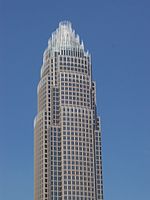
The Provident Institution for Savings (est.1816) in Boston, Massachusetts, was the first chartered savings bank in the United States. James Savage and others founded the bank on the belief that "savings banks would enable the less fortunate classes of society to better themselves in a manner which would avoid the dangers of moral corruption traditionally associated with outright charitable institutions."
History
19th century
"The leading citizens of Boston ... felt that participation in the administration of the savings banks in their was an integral part of their civic duties." Led by Savage, founders of the bank included William Ellery Channing, William Cochran, Thomas Dawes, Samuel Eliot, Jonathan Hunnewell, John Phillips, William Phillips, Jesse Putnam, Josiah Quincy, Richard Sullivan, Elisha Ticknor, Redford Webster. Boston's Catholic bishop, John Cheverus, provided significant start-up energy, since a savings bank would encourage virtuous thrifty behavior amongst his parishioners. Early meetings took place in the Exchange Coffee House. They agreed the "object of the institution" was "to provide a safe and profitable mode of enabling industrious persons of all descriptions to invest such parts of their earnings or property, as they can conveniently spare, in a manner which will afford them both profit and security.
In the first decades of its history, the Provident occupied several buildings in downtown Boston -- Court Street (ca.1817), in the courthouse; Scollay Square (1823–1833), in Scollay's building; Tremont Street (1833–1856), adjacent to King's Chapel Burying Ground; and Temple Place (beginning in 1856), in the former mansion of Thomas Handasyd Perkins.
At first, only people who lived in Boston or Charlestown were admitted as depositors. In 1822, the bank expanded its client base to include depositors from "Quincy, Milton, Dorchester, Dedham, Roxbury, Brookline, Waltham, Brighton, Newton, Weston, Cambridge, Watertown, West Cambridge, Medford, Saugus, Malden, and Chelsea." Although the Provident operated as a bank, in its early years it avoided the word "bank" "for the purpose of avoiding a certain sentiment of antipathy, which, at the time, appeared to be entertained toward the existing 'banks' by the common people." The amount of deposits increased dramatically through the years: deposits in 1820 totaled $233,034; in 1830, $986,959; in 1840, $2,071,095; and by 1900, $38,629,876.
Into the 19th century, the Provident's early spirit of civic benevolence and socio-economic inclusion may have diminished. According to one historian, the bank "sought large deposits, made timely loans to textile firms in which its directors were interested, and generally profiteered."
20th century
In 1986 the Hartford National Corp. bought the Provident Institution for Savings in Boston for $87.2 million. "The Provident became a wholly owned subsidiary of Hartford National. However, The Provident, which is the fourth-largest savings bank in Massachusetts, will continue to operate under the name it has been using since 1816." The bank kept its original name through 1992. In 1993, the Provident was merged into Shawmut Bank.
Images
-
 Courthouse, Court Square, where the Provident first kept offices, 1817
Courthouse, Court Square, where the Provident first kept offices, 1817
-
 Portrait of founder James Savage (1784-1873), by David Dalhoff Neal 1886
Portrait of founder James Savage (1784-1873), by David Dalhoff Neal 1886
-
 Scollay's Building, Scollay Square, Boston, where Provident Savings kept offices 1823-1833
Scollay's Building, Scollay Square, Boston, where Provident Savings kept offices 1823-1833
-
 Provident Savings building (at right, next to the Boston Museum), Tremont Street, Boston, 1833-1856
Provident Savings building (at right, next to the Boston Museum), Tremont Street, Boston, 1833-1856
-
 Former house of Thomas Handasyd Perkins, Temple Place, Boston, occupied by Provident Savings beginning in 1856
Former house of Thomas Handasyd Perkins, Temple Place, Boston, occupied by Provident Savings beginning in 1856
References
- ^ Provident Institution for Savings in the Town of Boston (1916), One Hundred Years of Savings Bank Service, Boston: Provident Institution for Savings, OCLC 11178812, OL 6620182M
- George S. Hillard (1878). Memoir of the Hon. James Savage, LL.D., late president of the Massachusetts Historical Society. Boston: John Wilson and Son.
- ^ Lance Edwin Davis; Peter Lester Payne (1958). "From Benevolence to Business: The Story of Two Savings Banks". Business History Review. 32 (4). ISSN 0007-6805.
- By-laws of the Provident Institution for Savings in the Town of Boston, 1816
- "History of the Massachusetts Savings Banks". Banker's Magazine and Statistical Register. 43 (2). 1889.
- Ronald D. Story (1977). "'That Damned Pack of Sharpers': Savings Banks and American Society in the Nineteenth Century". Reviews in American History. 5 (3): 335–341. doi:10.2307/2701009. JSTOR 2701009.
- "Bank Purchase Approved". Boston Globe. March 1, 1986.
- "Hartford Nat'l-Provident". Boston Globe. April 2, 1986. p. 66.
- Bank Directory of New England. 1987–1992.
- Financial Institutions Directory, Massachusetts Bankers Association, 1993
Further reading
- Henry Lee (1893), A Massachusetts savings bank: being an account of the Provident Institution for Savings: together with a discussion of some problems of savings-bank management and legislation, Committee on Charities and Correction to Massachusetts Board of Managers, World's Fair, OL 601606M
- Court, United States Supreme (1911). "221 US 660 Provident Institution for Savings in the Town of Boston v. Dana Malone". p. 660.
- Walter Muir Whitehill (1966), The Provident Institution for Savings in the Town of Boston, 1816-1966, Boston
{{citation}}: CS1 maint: location missing publisher (link)
42°21′30.79″N 71°3′35.23″W / 42.3585528°N 71.0597861°W / 42.3585528; -71.0597861
Categories: